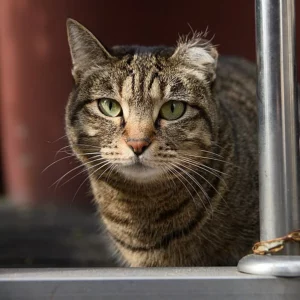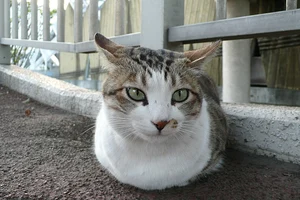Did you know cats speak through their ears? Yes, you heard it right. They go beyond typical vocalization and use silent semaphore language to express themselves.
Numerous clues about a cat’s mood or next move can be found in their nonverbal communication, such as how their ears move. A cat’s ears are never moved without a valid reason. So, there is always a range of why’s, when’s, and what’s associated with a cat’s ear movements.
Cat parents may easily determine their feline babies’ emotions by seeing how their ears are held. Cats use their ears to convey various emotions, including curiosity, agitation, unease, anger, and more.
This post is for cat parents who are curious about the meaning behind their cat’s ear movements. We will go through the detail of cats’ lowering (and moving) their ears and decipher all the related queries.
So, without any further delay, let’s begin!
Understanding a cat’s ears
Cats have “ear language.” Yes, they speak through their ears long with vocalization and using other body gestures to communicate. So, it’s worth focusing on analyzing a cat’s ears.
Cats are particularly sensitive to sound and have a wide range of audible frequencies. Even dogs cannot match their hearing. Additionally, cats utilize their ears to communicate their emotions.

Yu Tae-wook (CC0 1.0) from Wikimedia
That said, a cat’s ears are divided into three sections: the outer, middle, and inner. The pinna and ear canal make up the outer ear, whereas the eardrum and ear chambers make up the middle ear. The inner ear is the organ that affects a cat’s life the most. It houses the vestibular system and cochlea, which are crucial for a cat’s agility and superb sense of balance.
You can also touch the cat’s ear to determine its body temperature. For example, your cat’s ears would be warmer if it were under stress or feverish.
What do the various cat ear placements indicate?
For most people, cats are mysterious creatures and also the most misunderstood. But if you are a cat lover, you can understand that cats communicate pretty straightforwardly, even in the most unconventional way.
Ears are the organs in cats that speak a lot about their emotions. So, below are the different placements of ears that indicate different moods in cats.

Neutral
The ears in a neutral posture show that your cat is not experiencing any particular strong emotion. It has a neutral attitude. A cat’s neutral ears likewise show its content and at ease. It can be a great time to pick your cat up and snuggle it!
Ear Turned Up
If your cat hears something and is paying close attention to it, you will see its ears turned up and forward. In such a situation, your cat may think, “what is that sound? Where is it coming from? Or, what’s going on”?
While playing with your cat, you could also notice its ears pointed upward and forward. Likewise, your feline baby shows curiosity and interest while playing and hunting, expressed by its pointed ears.
Ear Turned Back
You should pay attention to your cat if the ears are turned back. A backward-turned ear posture denotes annoyance and overstimulation. If you see your cat moving its ears like this, it’s best to leave it alone.
Ear Lowered
Without a doubt, a lowered ear posture means “step off.” In other words, your cat is attempting to express that it is agitated and about to be aggressive. If you continue to interact with your furry friend while ignoring this body language, you risk incurring its fury in the form of scratches and bites. When a cat’s ears are in this position, people should back away from the creature.
An additional tip for all cat lovers- to confirm if your kitty is angry, along with its ears, look at its eyes. They do a lot of talking through their eye. And the eyes of an angry kitty will be like “don’t mess with me!”
Ear Turned Sideways or Backward
Your cat may be concealing an illness or acting fearful if its ears are low, facing out, or in a sideways position. Unfortunately, cats are masters at disguising health issues. However, you can tell if your pet is sick if you pay to the position of their ears. Additionally, you must search for additional possible symptoms and examine your cat’s eyes and tail if you suspect an illness.
What does it mean when cats’ ears are down?
So you have a cat with lowered ears and do not know what it means? Don’t worry, as we will explain what different types of lowered ear postures indicate about a cat’s mood.
Here are the various means that lowered cat ears can indicate.
Angry
A hazardous cat is an enraged cat. The good news is that it is possible to determine your cat’s anger. The ears of a furious cat would have been pushed back or flattened close to the head. As the cat prepares to jump, this stance keeps its ears out of the reach of its fangs and claws. Avoiding a furious cat is preferable because being unaware can lead to bites and scratches from the cat.
Scared
A cat’s ears are flattened, turned sideways, or backward indicates fear or anxiety. Your cat may act aggressively to deal with its fear. However, you can check your cat’s pupils to be sure it is truly feeling scared. You can tell a cat is scared and preparing to escape or fight if its ears are lowered backward or sideways, and its pupils are black and dilated. This ear position is also accompanied by excessive vocalization.
Uncomfortable
It may indicate that your cat is nervous if its ears are turned down and to the sides. The kitty’s ears would be protrusions on each side resembling airplane wings. It is a symptom that your cat feels threatened and uneasy due to whatever is happening in its immediate environment. Try to identify the triggers to control the situation and work to get rid of them.
Feeling Sick
If your cat has lowered ears and a drooping face, you may be sure it is not in good health. According to Sage Journals, cats are lonely animals skilled at concealing their problems. Domestic cats fall under the same category as well. However, if your kitten’s head and ears are consistently lowered along with its ears, you can tell whether it has a potential sickness.
Why does my cat twitch its ears?

Have you ever noticed your cat twitching its ears? In other words, what does it mean if your cat has one ear down with the other one straight?
Sometimes twitching may be uncontrollable. However, if it is voluntary, it could indicate that your cat is uncertain or confused. The cat’s ear posture also suggests that it is trying to concentrate on what it hears to figure out. This ear position is especially noticeable when your cat is introduced to anything new.
The cat may suffer from an ear issues or damage, another cause of twitching. Because it hurts, a cat will drop one ear down to keep people away from the ear canal.
Why do cats flatten their ears when playing?
A cat remains agitated and excited while playing. Play session for cats is similar to their hunting session. And it is while playing that cats often lower their ears. But why do they do so?
For cats, a toy or moving hand is similar to prey. Cats frequently try to jump on them while playing with them to catch, bite, and scratch. Their predation drive is in action at this time, as seen by their lashing tail and ears that are flattened and pupils dilated. Normal play usually results in this posture, followed by biting and scratching.
As we’ve already mentioned, cats’ pushed-back and lowered ears indicate aggression. You will frequently see the same ear stance when you and your cat are playing. The only difference is that while playing, it will mostly be play aggression, not a real, more severe one. Additionally, excessive stimulation from playing can flatten your cat’s ears.
However, if your cat exhibits significant hostility in addition to this ear posture, it may behave inappropriately. To have a detailed understanding of this, keep a record of its behavior and adopt behavior management aids.
Why do cats lower their ears when you pet them?
The world’s best feeling can be experienced when you pet your cat. You have the opportunity to strengthen your relationship with your furry friend at this time.
A cat that enjoys being petted by its human would frequently slightly lower its ears. This is because it has a calm and joyful feeling about it. Your cat will be sitting with its ears dropped, eyes closed, and occasionally purring.
If your cat displays this ear posture, you should keep petting it and enjoy your time together. Keep in mind that this is the period when your cat is most trusting of you and is lowering its guard.
Summary
So, the key takeaway of this post is that there are several meanings that a cat can convey by displaying a lowered ear posture. However, to understand its real meaning, you must check the cat’s other body language. No communication happens in isolation. So, keep a close eye on the overall body language of your cat and its surroundings to understand the true reason behind your cat’s lowered ear posture.
Remember, cats are vocal; we only need to have ears to hear them.
